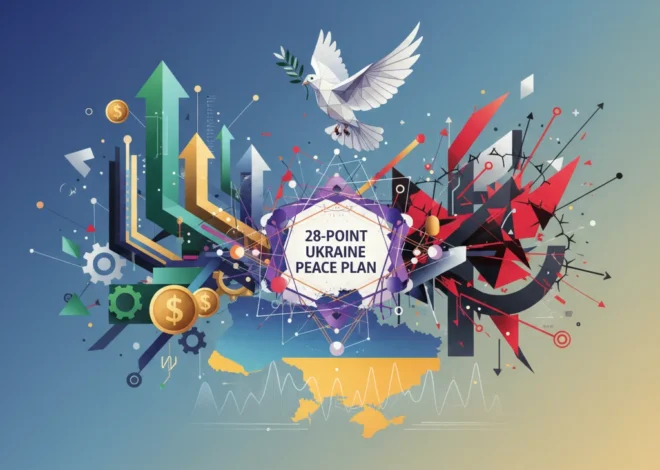
The Price of Peace: Decoding the Economic Fallout of a Proposed US-Russia Deal for Ukraine
In the high-stakes world of geopolitics, whispers of back-channel negotiations can send shockwaves through the global economy. A recent bombshell report has done just that, suggesting a potential US-Russia brokered peace plan for Ukraine is on the table—one with a staggering cost for Kyiv. According to sources cited by the Financial Times, Ukrainian President Volodymyr Zelenskyy is facing immense pressure to accept terms that could involve ceding sovereign territory in exchange for an end to the conflict. While the human and political ramifications are profound, for investors, finance professionals, and business leaders, the critical question is: what does this mean for the markets?
The delicate dance of diplomacy has always been inextricably linked with the flow of capital. A potential resolution to Europe’s largest land war in generations isn’t just a political headline; it’s a seismic event with the power to reshape investment landscapes, realign supply chains, and redefine economic risk for years to come. This article delves beyond the battlefield to analyze the financial undercurrents of this proposed peace, exploring the potential impact on everything from the stock market and commodity prices to the future of international banking and financial technology.
The Geopolitical Gambit: A Deal on the Table?
The core of the reported plan is a classic, if deeply controversial, “land for peace” formula. The proposal allegedly calls for Ukraine to relinquish control over territories currently occupied by Russia. In return, the conflict would cease, potentially paving the way for a new security architecture in Eastern Europe. Ukrainian officials, as per the FT report, feel they are being pushed into a corner, forced to choose between national sovereignty and the cessation of a brutal, resource-draining war.
This development comes after more than two years of devastating conflict that has not only ravaged Ukraine but also sent ripples across the global economic system. Western nations responded to the 2022 invasion with an unprecedented wave of sanctions, targeting Russia’s banking sector, energy exports, and access to global finance. The goal was to cripple Moscow’s war machine, but the blowback included soaring energy prices, disrupted grain shipments, and a spike in global inflation. As the World Bank noted in its 2023 outlook, the war has significantly slowed global economic growth, with developing nations feeling the sharpest impact (source). It is within this context of global economic fatigue that the pressure for a settlement, however imperfect, is mounting.
The Trillion-Dollar Question: How European Courts Are Reshaping the Future of Energy Investing
Market Reactions: Volatility or a “Peace Dividend”?
For those engaged in investing and trading, the primary concern is market reaction. How would the stock market digest such a monumental development? The initial response would likely be a “risk-on” rally. The removal of a major source of geopolitical uncertainty could unleash a wave of optimism.
- Energy Markets: A durable ceasefire would likely cause a significant drop in oil and natural gas prices. The risk premium that has been baked into energy costs since February 2022 would evaporate, providing relief to consumers and businesses worldwide and easing inflationary pressures.
- Equities: European markets, which have borne the brunt of the economic fallout, would stand to gain the most. Sectors like manufacturing, automotive, and consumer goods, which are highly sensitive to energy costs and consumer confidence, would likely see a sharp rebound. Defense stocks, on the other hand, might experience a sell-off after a multi-year bull run.
- Agriculture & Commodities: Ukraine is a global breadbasket. A secure peace deal would reopen Black Sea ports fully and stabilize the global supply of wheat, corn, and sunflower oil, leading to lower food prices.
However, the nature of the peace deal matters immensely. A fragile, contentious agreement that leaves key issues unresolved could simply replace one form of uncertainty with another. The long-term stability of such a settlement would be heavily scrutinized, and any signs of it unraveling could trigger renewed volatility.
The Economics of Reconstruction and the Role of Fintech
Beyond the immediate market reaction lies the colossal task of rebuilding Ukraine. The Kyiv School of Economics estimates the cost of reconstruction to be upwards of $750 billion, a figure that grows with each passing day of conflict (source). This presents both a monumental challenge and a significant economic opportunity.
This is where modern finance and financial technology will play a pivotal role. The reconstruction effort will require a massive influx of public and private capital, managed with unprecedented levels of transparency to combat corruption. This is a prime use case for blockchain technology. Distributed ledgers could be used to track aid funds from donor to project, ensuring every dollar is accounted for. Smart contracts could automate payments to contractors upon completion of verified project milestones, increasing efficiency and reducing graft.
Moreover, the war has accelerated Ukraine’s digital transformation. The country has been a surprising leader in cryptocurrency adoption and has leveraged fintech solutions to maintain financial stability amidst the chaos. This digital infrastructure will be a cornerstone of its economic recovery, enabling efficient capital flows and fostering a new generation of tech-driven industries.
Ghosts of Economic Past: Why a 1970s Socialist Blueprint Still Haunts Modern Finance
To better understand the divergent paths ahead, consider the potential economic outcomes of a continued conflict versus a negotiated peace settlement.
| Economic Factor | Scenario 1: Protracted Conflict | Scenario 2: Negotiated Peace Deal |
|---|---|---|
| Global Energy Markets | Sustained high prices and volatility; continued supply chain risk. | Price stabilization and likely decrease; reduced risk premium. |
| Stock Market Outlook | Persistent uncertainty weighing on European and global equities; defense sector outperforms. | Broad-based “risk-on” rally, particularly in Europe; construction and consumer sectors benefit. |
| Global Inflation | Inflation remains stubbornly high due to energy and food costs. | Significant disinflationary pressure, giving central banks more policy flexibility. |
| Investing in Ukraine | Extremely high-risk, limited to humanitarian aid and essential services. | Massive reconstruction boom; high-growth opportunities in infrastructure, tech, and agriculture. |
| Role of Fintech/Blockchain | Used for aid delivery, capital flight, and sanction evasion. | Pivotal for transparent reconstruction financing, digital banking, and economic modernization. |
A New Chapter in Economic Statecraft
The resolution of this conflict, whatever form it takes, will have lasting implications for international economics. The scale and coordination of the sanctions against Russia have provided a powerful, if imperfect, template for future economic warfare. Global businesses and financial institutions have been forced to navigate a complex web of restrictions, fundamentally altering their risk calculus for operating in politically unstable regions.
The unwinding of these sanctions, should a deal be reached, will be as complex as their implementation. It will raise critical questions for the global banking system about reintegrating Russian entities and assets. Will the world snap back to the pre-2022 status quo? Unlikely. The conflict has accelerated a trend towards economic fragmentation and the formation of rival blocs. Business leaders and investors must now operate under the assumption that a country’s geopolitical alignment is a primary factor in its economic viability.
The Paradox of India's Growth: Why a Booming Economy is Begging for a Spending Spree
Conclusion: Navigating the Intersection of Power and Profit
The report of a potential US-Russia peace plan for Ukraine is more than a diplomatic headline; it is a critical inflection point for the global economy. For the general public, it signals a potential end to a devastating conflict. For those in finance, investing, and business, it signals a period of profound transition, fraught with both opportunity and risk.
A peace deal, even a deeply flawed one, would likely trigger a short-term market rally and ease the inflationary pressures that have plagued the global economy. The long-term picture, however, is far more complex. The reconstruction of Ukraine will be a multi-decade project, potentially supercharged by innovations in fintech and blockchain. Simultaneously, the crisis has permanently altered the landscape of global trading and economics, elevating geopolitical risk to the forefront of every investment decision. The price of peace may be steep, but for the prepared investor, understanding its economic consequences is priceless.


